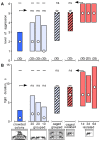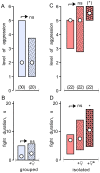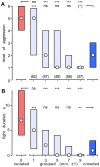Isolation associated aggression--a consequence of recovery from defeat in a territorial animal
- PMID: 24040368
- PMCID: PMC3765410
- DOI: 10.1371/journal.pone.0074965
Isolation associated aggression--a consequence of recovery from defeat in a territorial animal
Abstract
Population density has profound influences on the physiology and behaviour of many animal species. Social isolation is generally reported to lead to increased aggressiveness, while grouping lowers it. We evaluated the effects of varying degrees of isolation and grouping on aggression in a territorial insect, the Mediterranean field cricket, Gryllus bimaculatus. Substantiating early observations, we show that dyadic contests between weight-matched, adult male crickets taken from groups rarely escalate beyond threat displays, whereas interactions between pairs of previously isolated crickets typically escalate to physical fights lasting several seconds. No significant differences were found between 1, 2 and 6-day isolates, or between individuals grouped for a few hours or lifelong. Unexpectedly, crickets grouped in immediate proximity within individual mesh cages that precluded fighting while permitting visual, olfactory and mechanical, antennal contact, were as aggressive as free isolates. This suggests that reduced aggression of grouped animals may be an acquired result of fighting. Supporting this notion, isolated crickets initially engage in vigorous fights when first grouped, but fighting intensity and duration rapidly decline to the level of life-long grouped crickets within only 10 min. Furthermore, grouped crickets become as aggressive as life-long isolates after only 3 hours of isolation, and on the same time course required for crickets to regain their aggressiveness after social defeat. We conclude that the reduced aggressiveness of grouped crickets is a manifestation of the loser effect resulting from social subjugation, while isolation allows recovery to a state of heightened aggressiveness, which in crickets can be considered as the default condition. Given the widespread occurrence of the loser effect in the Animal Kingdom, many effects generally attributed to social isolation are likely to be a consequence of recovery from social subjugation.
Conflict of interest statement
Figures




References
-
- Cacioppo JT, Hawkley LC (2009) Perceived social isolation and cognition. Trends Cogn Sci 13: 447-454. doi:10.1016/j.tics.2009.06.005. PubMed: 19726219. - DOI - PMC - PubMed
-
- Krohn TC, Sorensen DB, Ottesen JL, Hansen AK (2006) The effects of individual housing on mice and rats: a review. Anim Welf 15: 343-352.
-
- Lihoreau M, Brepson L, Rivault C (2009) The weight of the clan: even in insects, social isolation can induce a behavioural syndrome. Behav Processes 82: 81-84. doi:10.1016/j.beproc.2009.03.008. PubMed: 19615616. - DOI - PubMed
-
- Simpson JS, Sword GA (2009) Phase polyphenism in locusts: mechanisms, population consequences, adaptive significance and evolution. In Whitman DW, Ananthakrishnan TN, Phenotypic Plasticity of Insects, Mechanisms and Consequences. Enfield: Science Publishing House Publishers; pp. 147-189.
-
- Sokolowski MB (2010) Social Interactions in ‘‘Simple’’ Model Systems. Neuron 65: 780-794. doi:10.1016/j.neuron.2010.03.007. PubMed: 20346755. - DOI - PubMed
Publication types
MeSH terms
LinkOut - more resources
Full Text Sources
Other Literature Sources

